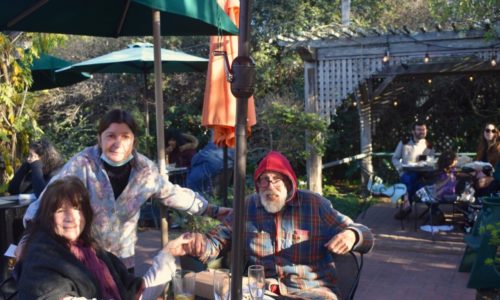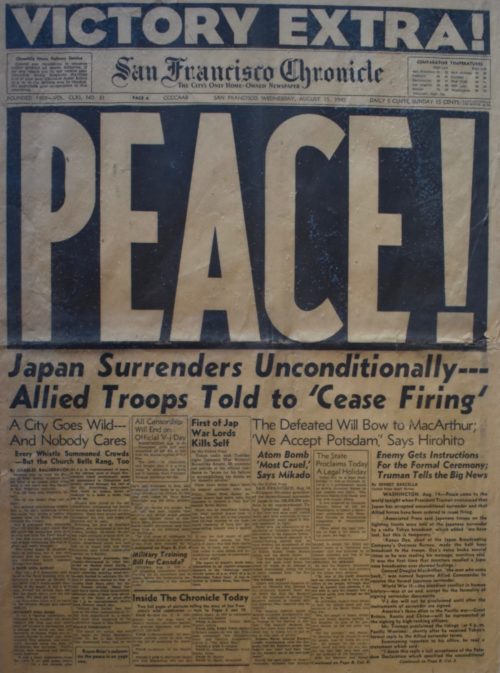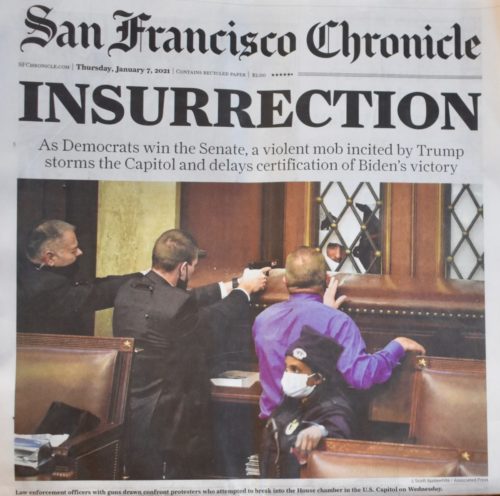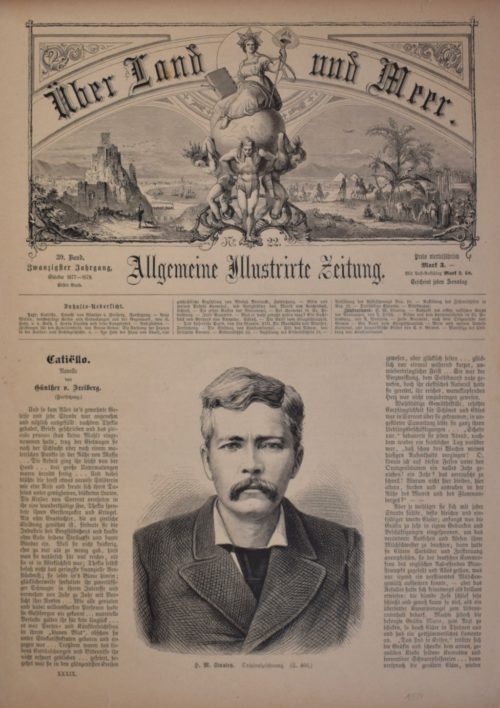Caveat lectorem: When readers submit comments, they are asked if they want to receive an email alert with a link to new postings on this blog. A number of people have said they do. Thank you. The link is created the moment a posting goes online. Readers who find their way here through that link can see an updated version by simply clicking on the headline above the posting.

Birthday lunch. Maddy Sobel of Point Reyes Station (standing) took my wife Lynn and me out for lunch at the Station House Cafe Tuesday to celebrate my 78th birthday.
Because of Covid restrictions, the cafe’s only seating was outdoors in the garden, which was attractive but chilly enough to warrant my wearing a hood while eating.
Now in my 79th year, I’m enjoying myself but have problems walking and remembering things. In short, I am definitely slowing down.
When I was born on Nov. 23, 1943, the US was about halfway through our involvement in World War II. My parents and I were living in the Marina District of San Francisco, and though I was too young to understand what I was seeing, my parents later told of freight trains chugging past the Marina Green carrying tanks and other military vehicles to ships heading off for the war in the Pacific.
The one thing I do remember of the war was the Japanese surrender on Sept. 2, 1945. China had been our ally against Japan, and the surrender prompted a massive celebration in Chinatown. Hearing about it, my mother loaded great aunt Amy and me into our family’s Pontiac and drove across town so we could see it first hand. The merriment no doubt was exciting, but as a two year old, I found it terrifying. Firecrackers were exploding everywhere, and as we headed up Grant Avenue, they started raining down on our car from overhead balconies. The traffic was so heavy, mom couldn’t immediately drive away, and for the next couple of years, loud noises — even from kids’ cap guns — frightened me.
Merely growing up in the United States has meant my lifetime’s been filled with warfare: World War II (1941-45); the Korean War (1950-53); the Vietnamese, Laotian, and Cambodian Wars (1956-75); two wars in Iraq (1990-91 and 2014-17); and the Afghan War (2001-present). I never fought in any of these wars, but I did witness a couple of others. In 1984, while working as a reporter for The San Francisco Examiner, I was sent to Central America to cover the wars then being fought in El Salvador and Guatemala. All this left me with a sense that the world is never going to be peaceful, at least not in my lifetime.
Just keeping happy is enough for me these days. I spend afternoons carrying armloads of firewood into the living room and spend evenings sitting by the fireplace, smoking, listening to jazz from an earlier era, and chatting with Lynn when she’s not in the bedroom watching British murder mysteries on the TV. Keep calm and carry on, she says.
Perhaps it’s just the newspaperman in me, but over the years I’ve collected numerous front pages reporting historic events. How events were covered as they unfolded often determines how they are remembered.

No other front page ever brought so much joy to my family as this San Francisco Chronicle on Aug. 15, 1945, shortly before my second birthday.

The Berlin Wall is breeched.
“The fall of the Berlin Wall,” Nov. 9, 1989, was a pivotal event in world history which marked the falling of the Iron Curtain and the start of the fall of communism in Eastern and Central Europe,” to quote Wikipedia. “The fall of the inner German border took place shortly afterwards. An end to the Cold War was declared at the Malta Summit three weeks later, and the reunification of Germany took place in October the following year.”

It’s now mostly forgotten, but before the fall of the Berlin Wall, British Prime Minister Margaret Thatcher told Soviet General Secretary Mikhail Gorbachev that neither the United Kingdom nor Western Europe wanted the reunification of Germany. She said they feared a revival of German imperialism, but the argument didn’t hold.

A new day in America.
Despite pockets of racism, the United States elected Barack Obama its first Black president in 2008 and reelected him in 2012.

Officers with guns drawn confront protesters breaking into the House chamber.
But now we have an insurrection with a pro-Trump mob breaking into the US capital building on Wednesday in an attempt to stop the Electoral College from confirming Joe Biden as our president-elect. Five people were killed, windows were broken, doors were smashed, vandals damaged the building’s interior.
The FBI is investigating, and it seems that the Trump crowd may be planning additional riots in each state on or around Jan. 20, when Biden will be inaugurated as our new president.
The violence has shocked the Western world but was gleefully reported in Russian and Chinese news media.
______________________________
Rather than end with news as dreadful as the pro-Trump insurrection, I’ll take a jump back to earlier times when deeds counted more than lies.

Henry Morton Stanley on the cover of Allgemeine Illustrite Zeitung, 1877.
“On March 21, 1871, Henry Morton Stanley set out from the African port of Bagamoyo on what he hoped would be a career-making adventure. The 30-year-old journalist had arrived on the Dark Continent at the behest of the New York Herald newspaper,” the website History relates. “He had been placed in charge of a grand expedition to find the explorer David Livingstone, who had vanished in the heart of Africa several years earlier.
“Dr. Livingstone was the most renowned of all the explorers of Africa. Among other exploits, the Scottish missionary and abolitionist had survived a lion attack, charted the Zambezi River and walked from one side of the continent to the other. In 1866, he had embarked on what was supposed to be his last and greatest expedition: a quest to locate the fabled source of the Nile River.
“The mission was supposed to last two years, yet by 1871, nearly six years had passed with only a few scattered updates on Livingstone’s whereabouts. Many Europeans had given him up for dead.
“Stanley knew that Livingstone had last been spotted in the vicinity of Lake Tanganyika, but reaching the area proved to be a monumental task. Between March and October of 1871, the New York Herald expedition endured repeated setbacks as it trudged though endless miles of swampland and jungle. Crocodiles and swarming tsetse flies killed their pack animals, and dozens of porters abandoned the caravan or died from illnesses. By the time they arrived at Ujiji, a remote village in what is now Tanzania, they had crossed more than 700 miles of territory.
“On Nov. 10, 1871, after hearing rumors of a white man living in Ujiji, Stanley donned his finest set of clothes and entered the town with a small band of followers. As crowds of locals gathered around them, Stanley spied a sickly-looking European with an unruly beard and white hair.
“Sensing that he had found his man, he approached, extended his hand, and asked a now-famous question: ‘Dr. Livingstone, I presume?’ When the stranger answered in the affirmative, Stanley let out a sigh of relief. ‘I thank God, doctor, I have been permitted to see you,’ he said.
“After being resupplied by Stanley, [Livingston] parted ways with his rescuers in March 1872 and made his way south to Lake Bangweulu in modern day Zambia. His illnesses later caught up with him, however, and he died from malaria and dysentery on May 1, 1873.”







